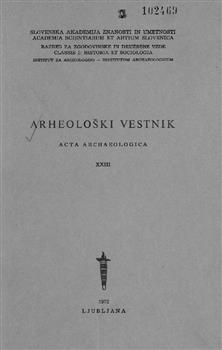Staroslovansko grobišče v Zgornjem Dupleku
Povzetek
On the graminaceous slope (plot Nos. 296/2 and 298, pertaining to Zgornji Duplek cadastre; fig. 3), on the estate owned by Jernej Purgaj, Zgornji Duplek 175 (8 km SE—from Maribor; fig. 1), a “contracted skeleton”, together with a ceramic pot (probably A 2877, fig.), was discovered in 1932. While digging for sand in 1975, the locals came again across skeleton graves at the same spot. The first recognitory and protective measures were apparently carried out by Stanko Pahič (of the Provincial Museum, Maribor), and by Mira Strmčnik- Gulič (of the Institution for Protection of Monuments, Maribor), who documented the three skeleton graves (Nos. 2—4; fig. 4).1 From April 21 to 29, 1975, the authors of this report carried out additional protective digging on the threatened archaeological ground (fig. 5). Consequently was examined the eastern and the northern edge (4 m in width) of the sandpit, where the five skeleton graves were situated (Nos. 5—9; fig. 4).2 The finds from the graves are kept by the Provincial Museum, Maribor, inventory Nos. A 2975—A 2993.3 In the cemetery at Zgornji Duplek, where further excavations could possibly give further results, nine skeleton graves have been discovered to date. The oval and tub shaped grave •ts (as can be assumed on the basis of the preserved outlines in the graves 5, 8, and 9) P* jug into the sandy base through a layer of humus (depth of up to 1 m). The aves 2 to 9 were pointed towards the east, with a maximum deviation of 14° towards the north. In all graves grave goods were found, predominantly pottery, with exception of a weapon (grave No. 3), and jewellery (grave No. 5). The pottery (without pot A 2877) consits of vessels with out-turned upper rims (to mention that there appeared some undeterminable parts and fragments), made on hand driven tter’s wheel: the outer surfaces are wavy, even slightly ridgy at times and in general not rnoothed as well as the upper rims, while the inner surfaces show signs of vertical strokes with fingers. The vessels are ornamented with wavy incisions (PI. Is 1, 2, 6, 7; 2: 3—5; 3: 1 3 5), with horizontal grooves (PI. 2: 4; 3: 3—5), with imprints in the shape of drops (PI. 3: 4) and with vertical short incisions (PI. 1: 1). The ornamentation is arranged mostly in strips. The bases of the three vessels show potter’s insignia: cross in a circle (Pl. 1: 6; 2: 3), and a wheel with eight spokes (PI. 3: 1). Clay is more or less mixed with silicic grains, with exception of two pots of which clay is mixed with uncrushed sand (graves 4 &5). The pots appear in three dimensions: small (ht. 8.0 cm; PI. 3: 5), medium (ht. up to 13.7 cm; Pl. 1: 2, 6; 2: 3, 4; 3: 4), and large (ht. up to 20.6 cm: PI. 1: 1, 7; 2; 5; 3: 1, 3). Arms are represented by a 22.2 cm long iron knife with a groove on each side of the blade, serving for drainage of blood (Pl. 1: 3), while jewellery is represented by two ear-rings (a pair, although not identical), made of silver wire, and with pending clusters in filigree ornamentation (PI. 2: 1, 2; fig. 2 a, b). The closest comparisions to the burial ground at Zgornji Duplek are: -the necropolis at Turnišče (apart from the analogies for pottery, note also comparision as regards the ear-ring: PI. 2: 2; fig. 2 b)5, the necropolis at Brezje nad Zrečami (also comparision for battle-knife: PI. 1: 3),6 an<J to a lesser extent the older phase of the cemetery at Ptuj-grad (fig. I).7 As regards Slovenia, separate graves with ceramic grave goods are also known to have been found at Dobova, at Roje pri Moravčah, ait Puščava pri Starem trgu, and in the region of Gorenjska (i. e. Srednje Bitnje pri Kranju, Kranj—Gorenja Sava, Begunje, Bled—Mlino gle(j—Žale).8 Outside the territory of Slovenia, related cemeteries appear in the area of Great Moravia,9 in the Lower Austria,10 in the Panonian Croatia,11 and in Dalmatia.12 Although only neighbouring areas are allotted by this manner, and not the whole territory where graves with pottery appear, the significance of the little cemetery at Zgornji Duplek is clearly stipulated: it is one of the Old Slavic cemeteries with pre-Christian burial rites, taking place partially in the 8th, but predominantly in the 9th century.
Prenosi
Prenosi
Objavljeno
Kako citirati
Številka
Rubrike
Licenca

To delo je licencirano pod Creative Commons Priznanje avtorstva-Nekomercialno-Deljenje pod enakimi pogoji 4.0 mednarodno licenco.
Avtorji jamčijo, da je delo njihova avtorska stvaritev, da v njem niso kršene avtorske pravice tretjih oseb ali kake druge pravice. V primeru zahtevkov tretjih oseb se avtorji zavezujejo, da bodo varovali interese založnika ter da bodo povrnili morebitno škodo.
Podrobneje v rubriki: Prispevki





